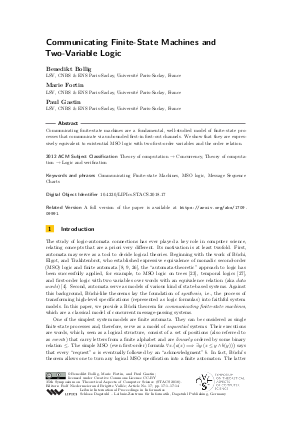Communicating Finite-State Machines and Two-Variable Logic
Authors Benedikt Bollig, Marie Fortin, Paul Gastin
-
Part of:
Volume:
35th Symposium on Theoretical Aspects of Computer Science (STACS 2018)
Part of: Series: Leibniz International Proceedings in Informatics (LIPIcs)
Part of: Conference: Symposium on Theoretical Aspects of Computer Science (STACS) - License:
 Creative Commons Attribution 3.0 Unported license
Creative Commons Attribution 3.0 Unported license
- Publication Date: 2018-02-27
File

PDF
LIPIcs.STACS.2018.17.pdf
- Filesize: 0.62 MB
- 14 pages
Document Identifiers
Subject Classification
Keywords
- communicating finite-state machines
- MSO logic
- message sequence charts
Metrics
- Access Statistics
-
Total Accesses (updated on a weekly basis)
0Document
0Metadata
Abstract
Communicating finite-state machines are a fundamental, well-studied model of finite-state processes that communicate via unbounded first-in first-out channels. We show that they are expressively equivalent to existential MSO logic with two first-order variables and the order relation.
Cite As Get BibTex
Benedikt Bollig, Marie Fortin, and Paul Gastin. Communicating Finite-State Machines and Two-Variable Logic. In 35th Symposium on Theoretical Aspects of Computer Science (STACS 2018). Leibniz International Proceedings in Informatics (LIPIcs), Volume 96, pp. 17:1-17:14, Schloss Dagstuhl – Leibniz-Zentrum für Informatik (2018)
https://doi.org/10.4230/LIPIcs.STACS.2018.17
BibTex
@InProceedings{bollig_et_al:LIPIcs.STACS.2018.17,
author = {Bollig, Benedikt and Fortin, Marie and Gastin, Paul},
title = {{Communicating Finite-State Machines and Two-Variable Logic}},
booktitle = {35th Symposium on Theoretical Aspects of Computer Science (STACS 2018)},
pages = {17:1--17:14},
series = {Leibniz International Proceedings in Informatics (LIPIcs)},
ISBN = {978-3-95977-062-0},
ISSN = {1868-8969},
year = {2018},
volume = {96},
editor = {Niedermeier, Rolf and Vall\'{e}e, Brigitte},
publisher = {Schloss Dagstuhl -- Leibniz-Zentrum f{\"u}r Informatik},
address = {Dagstuhl, Germany},
URL = {https://drops.dagstuhl.de/entities/document/10.4230/LIPIcs.STACS.2018.17},
URN = {urn:nbn:de:0030-drops-85298},
doi = {10.4230/LIPIcs.STACS.2018.17},
annote = {Keywords: communicating finite-state machines, MSO logic, message sequence charts}
}
Author Details
References
-
R. Alur and P. Madhusudan. Adding nesting structure to words. Journal of the ACM, 56(3):1-43, 2009.

-
N. Bedon. Logic and branching automata. Logical Methods in Computer Science, 11(4), 2015.

-
H. Björklund and T. Schwentick. On notions of regularity for data languages. Theoretical Computer Science, 411(4-5):702-715, 2010.

-
M. Bojanczyk, C. David, A. Muscholl, T. Schwentick, and L. Segoufin. Two-variable logic on data words. ACM Transactions on Computational Logic, 12(4):27, 2011.

-
B. Bollig, D. Kuske, and I. Meinecke. Propositional dynamic logic for message-passing systems. Logical Methods in Computer Science, 6(3:16), 2010.

-
B. Bollig and M. Leucker. Message-passing automata are expressively equivalent to EMSO logic. Theoretical Computer Science, 358(2-3):150-172, 2006.

-
D. Brand and P. Zafiropulo. On communicating finite-state machines. Journal of the ACM, 30(2), 1983.

-
J. Büchi. Weak second order logic and finite automata. Z. Math. Logik, Grundlag. Math., 5:66-62, 1960.

-
C. C. Elgot. Decision problems of finite automata design and related arithmetics. Transactions of the American Mathematical Society, 98:21-52, 1961.

-
M. J. Fischer and R. E. Ladner. Propositional Dynamic Logic of regular programs. Journal of Computer and System Sciences, 18(2):194-211, 1979.

-
B. Genest, D. Kuske, and A. Muscholl. A Kleene theorem and model checking algorithms for existentially bounded communicating automata. Information and Computation, 204(6):920-956, 2006.

-
B. Genest, D. Kuske, and A. Muscholl. On communicating automata with bounded channels. Fundamenta Informaticae, 80(1-3):147-167, 2007.

-
E. Grädel and M. Otto. On logics with two variables. Theor. Comput. Sci., 224(1-2):73-113, 1999.

-
M. Grohe and N. Schweikardt. Comparing the succinctness of monadic query languages over finite trees. In Proceedings of CSL'03, volume 2803 of Lecture Notes in Computer Science, pages 226-240. Springer, 2003.

-
W. Hanf. Model-theoretic methods in the study of elementary logic. In J. W. Addison, L. Henkin, and A. Tarski, editors, The Theory of Models. North-Holland, Amsterdam, 1965.

- Lauri Hella, Matti Järvisalo, Antti Kuusisto, Juhana Laurinharju, Tuomo Lempiäinen, Kerkko Luosto, Jukka Suomela, and Jonni Virtema. Weak models of distributed computing, with connections to modal logic. Distributed Computing, 28(1):31-53, 2015. URL: http://dx.doi.org/10.1007/s00446-013-0202-3.
-
J. G. Henriksen, M. Mukund, K. Narayan Kumar, M. Sohoni, and P. S. Thiagarajan. A theory of regular MSC languages. Information and Computation, 202(1):1-38, 2005.

-
D. Kuske. Infinite series-parallel posets: Logic and languages. In Proceedings of ICALP'00, volume 1853 of LNCS, pages 648-662. Springer, 2000.

-
D. Kuske. Regular sets of infinite message sequence charts. Information and Computation, 187:80-109, 2003.

- Antti Kuusisto. Modal logic and distributed message passing automata. In Simona Ronchi Della Rocca, editor, Computer Science Logic 2013 (CSL 2013), CSL 2013, September 2-5, 2013, Torino, Italy, volume 23 of LIPIcs, pages 452-468. Schloss Dagstuhl - Leibniz-Zentrum fuer Informatik, 2013. URL: http://dx.doi.org/10.4230/LIPIcs.CSL.2013.452.
- Fabian Reiter. Distributed graph automata. In 30th Annual ACM/IEEE Symposium on Logic in Computer Science, LICS 2015, Kyoto, Japan, July 6-10, 2015, pages 192-201. IEEE Computer Society, 2015. URL: http://dx.doi.org/10.1109/LICS.2015.27.
- Fabian Reiter. Asynchronous distributed automata: A characterization of the modal mu-fragment. In Ioannis Chatzigiannakis, Piotr Indyk, Fabian Kuhn, and Anca Muscholl, editors, 44th International Colloquium on Automata, Languages, and Programming, ICALP 2017, July 10-14, 2017, Warsaw, Poland, volume 80 of LIPIcs, pages 100:1-100:14. Schloss Dagstuhl - Leibniz-Zentrum fuer Informatik, 2017. URL: http://dx.doi.org/10.4230/LIPIcs.ICALP.2017.100.
-
J. W. Thatcher and J. B. Wright. Generalized finite automata theory with an application to a decision problem of second-order logic. Mathematical Systems Theory, 2(1):57-81, 1968.

-
W. Thomas. On logical definability of trace languages. In Proceedings of Algebraic and Syntactic Methods in Computer Science (ASMICS), Report TUM-I9002, Technical University of Munich, pages 172-182, 1990.

-
W. Thomas. Elements of an automata theory over partial orders. In Proceedings of POMIV'96, volume 29 of DIMACS. AMS, 1996.

-
B. A. Trakhtenbrot. Finite automata and monadic second order logic. Siberian Math. J, 3:103-131, 1962. In Russian; English translation in Amer. Math. Soc. Transl. 59, 1966, 23-55.

-
M. Y. Vardi and P. Wolper. An automata-theoretic approach to automatic program verification. In Proceedings of LICS'86, pages 332-344. IEEE Computer Society, 1986.

-
P. Weis. Expressiveness and Succinctness of First-order Logic on Finite Words. Ph.D. thesis, University of Massachusetts Amherst, 2011.

-
W. Zielonka. Notes on finite asynchronous automata. R.A.I.R.O. - Informatique Théorique et Applications, 21:99-135, 1987.

